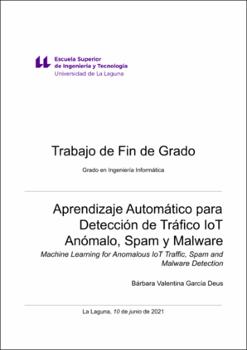Aprendizaje automático para detección de tráfico iot anómalo, spam y malware
Fecha
2021Resumen
El objetivo del presente trabajo es analizar diferentes aplicaciones del aprendizaje
automático en el campo de la ciberseguridad.
Como punto de partida se realiza una breve introducción a los conceptos básicos del
aprendizaje automático, las herramientas más sencillas para comenzar este tipo de
análisis y la construcción de modelos.
Dada la amplia variedad de contextos con los que se relaciona la ciberseguridad, se
han elegido tres de especial impacto en la seguridad de las organizaciones: los
dispositivos IoT, el spam y el malware.
La eclosión exponencial de los dispositivos IoT los ha convertido en origen de los
ataques más graves en los últimos años. Por ello, la detección temprana de anomalías en
este contexto resulta fundamental. Para este caso se ha empleado un algoritmo de
aprendizaje no supervisado.
En el caso del spam, vía de entrada de grandes estafas y de infección masiva de
equipos informáticos, se ha optado por el análisis del contenido de los correos empleando
varios modelos diferentes.
Por último, se ha trabajado sobre un repositorio de ficheros de diferentes tipos de
malware para tratar de discernir en qué casos podemos identificar no solo si se trata de
elementos maliciosos, sino también para tratar de identificar de qué tipo se trata en cada
caso. The objective of this work is to analyze different applications of machine learning in the
field of cybersecurity.
As a starting point, there is a brief introduction to the basic concepts of machine
learning, the simplest tools to start this type of analysis and the construction of models.
Given the wide variety of contexts with which cybersecurity is related, three have been
chosen with a special impact on the security of organizations: IoT devices, spam and
malware.
The exponential emergence of IoT devices has made them the source of the most
serious attacks in recent years. Therefore, early detection of anomalies in this context is
essential. For this case, an unsupervised learning algorithm has been used.
In the case of spam, the entry point for large scams and massive infection of computer
equipment, the analysis of the content of emails has been chosen using several different
models.
Finally, we have worked on a repository of files of different types of malware to try to
discern in which cases we can identify not only if they are malicious elements, but also to
try to identify what type it is in each case.





